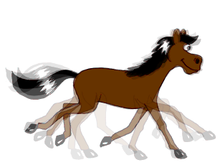Onion skin
The onion skin originally describes the semi-transparent layer of an onion . In the craft of animated film the onion skin called ( Engl. Onionskin ) a translucent pattern of the previously drawn frame.
technology
In 2D animation, the draftsman traditionally creates one single image after the other. In order to see what he had previously drawn, the cartoonists in companies like Disney created their scenes on semi-transparent, superimposed individual images ( tracing paper ), which were later photographed and put together to make a film. The onion skin technique allowed the artist to orientate himself on the previously drawn individual images and thus to create a continuous flow of movements long before the film was made.
Even with the transition from the drawing table to computer technology , the term was retained. The onion skin is created digitally in an animation program using semi-translucent layers. Most software packages for 2D animation allow you to choose how many layers of onion skin you want to see. In the example shown of a galloping horse you can see the sequence of movements through three onion skins. The paler the picture appears, the more onion skins (i.e. digital layers) lie between this and the currently drawn picture.
Individual evidence
- ↑ See for example Jason van Gumster, Robert Shimonski: GIMP-Bible , Wiley 2010, pp. 18 f., ISBN 978-0-470-52397-1 Google Books
